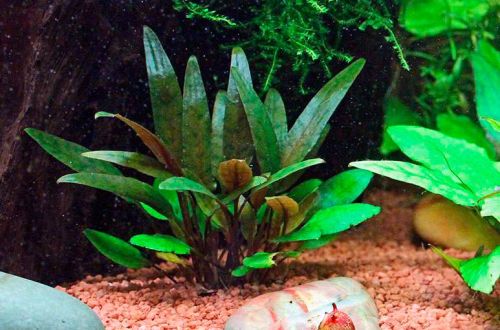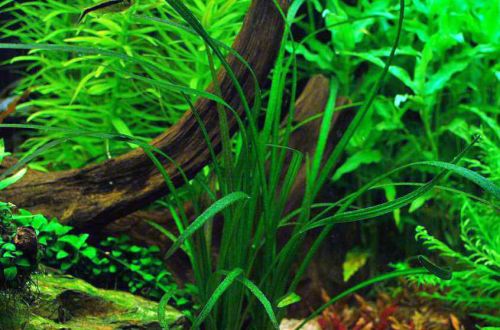
Cryptocoryne Beckett
Cryptocoryne Beckett, scientific name Cryptocoryne beckettii. It comes from Southeast Asia from the island of Sri Lanka, where it grows on moist soil along the banks of water bodies (rivers, lakes, swamps), as well as completely submerged in water. It is a related species of the well-known Cryptocoryne Wendt. Together with it, it has been used in the aquarium hobby since the 1960s. During this time, several new varieties have appeared, differing in size, shape and color of the leaves.

Cryptocoryne by Beckett Petch (Cryptocoryne beckettii «Petchii»), first image – was previously described as an independent species, but later attached to the Beckett’s Cryptocoryne group. Forms a leaf blade of a linear shape. The color of old leaves is dark green with a brownish underside. Young leaves are bright green.
Cryptocoryne Beckett Petch pink (Cryptocoryne beckettii «Petchii Pink»), second image – is a continuation of the breeding form of Cryptocoryne Beckett Petch. It was bred in 2012 by Anubias (Bologna, Italy). The plant has light reddish-brown leaves. In young shoots, pink tones predominate in the color of the leaves. This variety usually grows into compact bushes, making it suitable for use in nano aquariums.
Cryptocoryne Beckett green (Cryptocoryne beckettii «Viridifolia»), third image – this breeding form also appeared thanks to the efforts of the Italian company Anubias in 2013. The suffix “Viridifolia” in the scientific name is translated from Latin as “green leaf”, indicating the key feature of this variety.
It is considered a very simple and unpretentious plant. Can adapt to soft and hard water, not demanding on the degree of illumination and soil composition. However, high growth rates will only be shown with bright light, a nutrient substrate, and additional carbon dioxide. Able to grow not only in aquariums, but also in the humid environment of paludariums, subject to daily spraying. In the surface position, it can bloom, but much more often reproduction occurs by the formation of lateral shoots on the rhizome of the mother plant.




